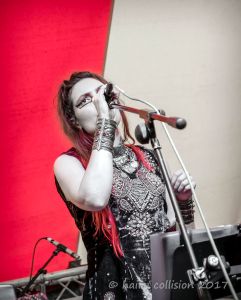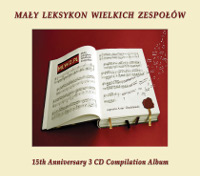According to Wikipedia, Cary is an American recording artist, singer, songwriter, musician, and record producer who plays guitar and analogue synthesizers. Needless to say, that doesn’t provide the full story, so it was only right that we sat down together to have a conversation.
Kev Rowland: Who, what and when is Cary Grace?
Cary Grace: Who: A hypnotist collector. An eternal student of the human condition. An explorer of my own mind. Whoever I feel like being when I wake up to begin a new day.
What: Well, the objective answer is around 65% water, 20% protein, etc., but Wikipedia will tell you all that. What I’d like to be, I mean, for posterity, is a body of artistic work that is a lot more permanent than this physical form; something that people will remember and keep alive in their hearts and minds after I’m gone. What are we good for if not the lasting creations which we leave behind?
When: Temporally misplaced, maybe. I have spent a lot of my life feeling like an anachronism. This is a very strange time to exist. It feels like an in-between sort of time, where there’s a lot of confusion and uncertainty about the future.
I love the art and creativity that still survives from ancient times in various places and from all different cultures. It seems like at least up through the beginning of the industrial revolution, it was kind of a “given” that aesthetics would be a big part of anything lasting which was created. Later in the 20th century we had superb design based on simple forms and lines, and even aesthetics derived from pure functionality, and I love that just as much for different reasons, but now...I am not sure what people are thinking most of the time. It seems to me that the idea of creating beautiful things to wonder at that will still be around for future generations to enjoy has been relegated to the garbage pile.
I identify quite a bit with the ethos and art and music of the 1960s and 1970s, and dislike most of what is called “popular” music now, and yet, paradoxically, I’ve been able to create my own music largely because of the very advances in technology which I think in some ways have helped to lead mainstream music astray.
Modern technology is amazing, but at the moment, it isn’t making everyone’s lives better yet (as I believe it should); most of it is owned by powerful corporations and is being mostly used to further greater and greater wealth inequality. I grew up watching Star Trek, so I (idealistically, perhaps) envision a future where wealth inequality isn’t really a thing, everybody has what they need to live, and there are truly equal opportunities for all. So, here I am in this weird in-between time that really doesn’t make a whole lot of sense, trying to survive and create my art. I expect this is no different though to what any artist feels trying to navigate their own time and place.
 KR: What are your earliest musical memories, and how did you first become involved in synthesisers?
KR: What are your earliest musical memories, and how did you first become involved in synthesisers?
CG: My grandmother was a very religious Methodist, and she was in the church choir, so being dragged to church was probably my first exposure to music. I remember getting a child-sized violin when I was very young, and then my dad stepping on it and crushing it shortly after. (Maybe I would have been a violinist...who knows?) Singing was something I enjoyed from a really young age.
Synthesizers (yes, with a “z”; it’s an American word as it applies to musical instruments, so I think it should keep the American spelling) are something I got heavily into after I moved to England. Though I had always had various (digital) keyboards and sound modules, I didn’t have much exposure at all to the world of analogue synthesis early in my music creating career.
It was kind of a revelation to me finding analogue synthesizers. Being able to sculpt the actual sounds in very expressive ways is quite appealing to me. I am in no way a virtuoso musician, so my musical expression comes out in other more subtle ways. The synthesizer is an ideal creative and expressive medium for me.
My first analogue synth loves were an EMS VCS3, and a Sequential Circuits Prophet 5. I have way too many of them now.
KR: You released your first album all the way back in 2004. How did that come about?
CG: With a lot of personal struggle, I’m afraid. It was a long time coming. I started writing songs in earnest and singing them probably ten years prior to that first release. Realised I couldn’t afford to pay for recording studio rates, so I built my own at home. Learned how to solder, how to wire things up. Figured out how to record tracks that I thought sounded half-way decent. Taught myself how to mix while mixing that album, in fact. It’s not the greatest album in the world, and I own that, but I still think it’s pretty decent for a first album. Probably could have been better if I’d had more help, but to give credit where it’s due, I did have some lovely help from generous people like Vince Gill, who played on a couple of the tracks. The musicians on that album are top notch—I mean, I was in Nashville. How could they not be?
You released your next album in 2007, what do you feel are the major differences between ‘Book of Rhymes’ and ‘Where You Go’?
I guess the biggest difference is that I was not even slightly trying to appeal to “normals” with the second album. I was in a new country, and making a new start, and was just being myself, unreservedly.
 KR: How did you get involved with analogue synthesizers, and how did the relationship with Wiard come about?
KR: How did you get involved with analogue synthesizers, and how did the relationship with Wiard come about?
CG: I had a radio programme for a few years called The Airtight Garage (the name an homage to Le Garage Hermétique by Moebius). In my searches for exciting and underrated music to share with my audience, I came across...I don’t recall how, but I did...an album called A Question for the Somnambulist, by a space rock band in Milwaukee called F/i. Somehow, I ended up corresponding with Grant Richter by email, and it so happened that he had a synthesizer company that was currently dormant due to his unfortunate ill health. Very soon, it became apparent that I would be the right person to take it on, so I did.
KR: You released five albums in quick succession, then it was four years and then another five until ‘Lady of Turquoise’. Why the change in approach?
CG: I don’t think there really was a change in approach. I always have and always will give each album as much time and attention as it needs, and it is finished when it is finished. Actually, in between Tygerland and Lady of Turquoise, I released two albums: the live album The Uffculme Variations, recorded at Kozfest with Steffe Sharpstrings and Graham Clark, and the compilation album Covers Volume I. Also, my work building synthesizers takes up a great deal of time (I build every module myself with my own two hands). I wish every day had at least 72 hours. Then I might just have a chance of getting caught up!
KR: How did you first become involved with Steffe Sharpstrings and Graham Clark?
CG: I met both of them for the first time either at, or on the way to, the Gong Unconvention in Amsterdam—if my memory serves, that was 2006. Anyway, I was introduced to both of them at different times by mutual friends and approached each to ask if they might be interested in playing on some of my records. They were both up for it!
I recall that my first introduction to Steffe was on the Gong tour bus on the way to the venue. He very graciously gave me a few minutes of instruction on his own version of the glissando guitar technique, including how to make my own playing utensil out of a butter knife (which I put to good use on some recordings later). Graham, I think I met on the street somewhere in Amsterdam, or possibly at the Melkweg during the event.
Collaborating with Graham happened first when I recorded Perpetual Motion. Those sessions over a long weekend were a truly magickal event, and I knew from the first notes played that I would be doing a lot more with Graham in the future!
Working with Steffe came later, and again, the first project we did was a recording session, much of which ended up on my Tygerland album. Steffe came over from London to stay for a weekend, and the band just jammed for hours and hours over a few days. I actually still have some material from that session that will be released someday (it just hasn’t quite fit anywhere yet).
I’ve played live with both of them several times since, as well as doing more recording, and it always is a pleasure to share the stage or studio with musicians of that calibre.
Both of them live pretty far away from me, so I don’t see either of them often, but when I do it is a real treat. They’re both lovely people, as well as incredible musicians.
 KR: You’ve said that neither of them had actually shared a stage until that day in Uffculme, and then most of the set was improvised. Can you describe what it was like that day?
KR: You’ve said that neither of them had actually shared a stage until that day in Uffculme, and then most of the set was improvised. Can you describe what it was like that day?
CG: Yes, that’s strange but true! Both of them had been in Gong (at different times), but they hadn’t yet played together. We didn’t rehearse with them either, due to distance, and all arriving to the festival from different places—but knowing what both of them and my other band mates are capable of, I wasn’t worried in the slightest. I knew that whatever we did, it would be good.
I’m not sure I recall anything about what the rest of the day was like—probably a pretty normal day at a festival (whatever that is), but the atmosphere on stage was one of electrifying creativity, and I’ll never forget the feeling. We only had maybe half an hour of material planned, but we had an hour set scheduled. The plan was to improvise for the rest, and that’s exactly what we did! I even wrote some lyrics on stage (“The Grand Theme of Things”). Don’t think I’ve ever done that before. It was exhilarating, and terrifying, and I’d love to do it again sometime!
KR: Your covers album is an unusual collection of songs from Cream to Dylan, Floyd to the Stones, how did you pick and choose them?
CG: They are all just songs I like and admire for various reasons, and thought I could add something new to and/or reinvent in some way. Songs that inspired me to re-create them in my own style. Some were originally B-sides for my own singles. Quite a few others were recorded for various Fruits de Mer Records compilations and singles. Those would tend to have a theme, or a specific artist to cover, chosen already, but I selected all the specific songs myself. Some of them were recorded before I started working with Fruits de Mer, and later ended up on one of their compilations (“Archangel’s Thunderbird” was one in that category that comes to mind).
The covers on that album were recorded over a pretty long period of time, too, so they also kind of reflect what I was doing musically at certain moments in time, and who I was working with at those times.
 KR: When I reviewed your most recent album, ‘Lady of Turquoise’, I said “the world is disappearing, I’m falling into a void”. What are you attempting to convey to the listeners and what are you hoping for them to experience?
KR: When I reviewed your most recent album, ‘Lady of Turquoise’, I said “the world is disappearing, I’m falling into a void”. What are you attempting to convey to the listeners and what are you hoping for them to experience?
CG: Well, that’s something I try not to do. Have (or at least, share) pre-conceived ideas about what the listener “should” experience. Music, to me, is a collaborative effort with the audience, not a strict language. By that, I mean I prefer to let the listener contribute some of their own reality to the experience rather than impose mine on them. So, I tend to avoid answering specific questions about what I meant by this or that (on the record, anyway). I’d rather the listener make up their own mind about it, because that will be more relevant to them personally than what I may or may not have meant anyway.
Even my own interpretations of my own work tend to change with time, or at least I find meanings in my songs later that I maybe wasn’t conscious of at the time, so I think it would be terribly restrictive to go on record as to what some of my lyrics “really mean”, or what any of my songs are “really about”. That might change next week, or ten years from now, anyway, so I’d rather allow listeners to explore that territory without my guidance! I think it’s more fun that way, and, as I said before, potentially more meaningful to them.
KR: You have recently worked on the Head Music 2 compilation where you covered “Surrounded By The Stars” (Amon Düül II). How did you approach this?
CG: I’ve been a big fan of that song since I discovered Amon Düül II. It was actually suggested by a fan that I ought to cover it, after hearing my version of “Archangel’s Thunderbird” by the same band.
My approach was the same as it usually is when covering other writers’ material: basically to distill a clear vision in my mind of what the song is at its heart, and what I think the song should be (if there’s anything I would have changed about the original execution of the recording and production), and trying to achieve whatever that is, as closely as I can.
With this one, my recollection is that we recorded rhythm tracks (drums and bass guitar) first, with me singing upstairs in the control room so Andy and Dave could hear me in their headphones to keep track of where they were. I think we did a few takes, then left it for a while as we were all pretty busy with other projects. At some point, I talked John into tracking some guitars at his studio, and after that was done, I did a session here with Graham Clark to lay down the violin track.
After that, I wrote some string parts, and added some synths and effects, and of course recorded the final vocal tracks, and did the mix.
 KR: What are you currently working on and what will be the next thing we hear from you?
KR: What are you currently working on and what will be the next thing we hear from you?
CG: I’ve begun the process of underpainting roughly what the next album is going to look like. I can’t really say how long it will take to finish it, only that it will take as long as it takes.
Obviously it has been more or less impossible to work closely with other people safely for the past year (physically, anyway), so I hope that things improve in the next several months on the virus front so we can do some recording sessions the way I prefer to do them, with a group of musicians all in one room together, bouncing off and building on each others’ ideas in realtime.
KR: Where can people go to find out more information about you and your music?
CG: My website (http://www.carygrace.com) is probably the best starting point, if you’re looking for biographical or discography information (I also have a blog there, where you will find reposts of album reviews, news, etc.), or if you want a central repository of links to all my social media accounts, etc., but if you just want to listen to some of my music as quickly and easily as possible, you can visit my Bandcamp page (https://music.carygrace.com), or look me up on Spotify, YouTube, or whatever music streaming platform appeals to you (most of my music is on most of them).
I would ask, though, if you like what you hear on Spotify or elsewhere, to please consider heading back over to my Bandcamp shop, and making a purchase of one of my handmade CD packages, posters, or T-shirts, or donating to my efforts via an artist subscription, because that is where all the funding comes from to record the next album, to maintain my recording equipment and instruments, to press the CDs. I haven’t done any gigs since the start of the pandemic, and I’m not sure how long it will be before it is safe to do gigs again, so the only place I am currently able to earn any income through music is really via my Bandcamp shop.
By the way, if you aren’t yet familiar with Bandcamp as a music retailer, please check out the site as a whole! I really believe that Bandcamp is where most of the good music has gone in the 2020s (good music certainly doesn’t show up on the mainstream channels very often anymore), and there is so much to explore there, whatever your tastes may be.
Oh, and also, please do connect with me on social media and come say ‘hello’. I’d love to hear from you! I’m on Facebook, Twitter, Instagram, etc., and I’m pretty easy to find. Talk soon.








